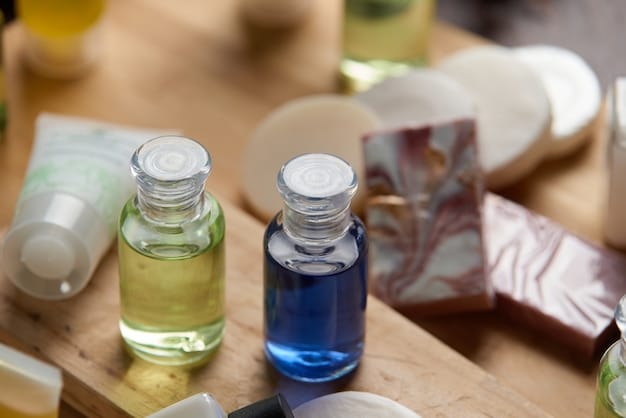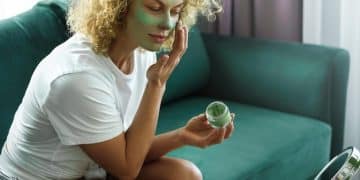How to Use Retinol Without Irritation: A Skincare Guide

Incorporating retinol into your skincare routine can be achieved without irritation by starting with a low concentration, applying it sparingly, using it only a few times a week, and pairing it with hydrating and soothing products to support the skin’s barrier.
Ready to unlock the anti-aging benefits of retinol without the dreaded irritation? This guide will show you how to incorporate retinol into your skincare routine without irritation, ensuring a smooth, glowing complexion.
Understanding Retinol and Its Benefits
Retinol, a derivative of vitamin A, is a powerhouse ingredient known for its ability to address a range of skincare concerns. Understanding its benefits and potential side effects is the first step to successfully incorporating it into your routine.
It’s important to know what retinol does and how it works before adding it to your skincare regimen to minimize any adverse reactions.
What is Retinol?
Retinol belongs to a group of compounds called retinoids, which are derived from vitamin A. These compounds work by increasing cell turnover, stimulating collagen production, and reducing the appearance of fine lines, wrinkles, and acne.
Key Benefits of Retinol
- Anti-Aging: Retinol helps reduce the appearance of fine lines and wrinkles by promoting collagen production.
- Acne Treatment: It can unclog pores and reduce inflammation, making it effective against acne.
- Improved Skin Texture: Retinol improves skin texture and tone, leading to a smoother complexion.
- Reduced Hyperpigmentation: It can fade dark spots and even out skin tone over time.
Retinol’s multi-faceted benefits make it a popular choice for those looking to improve their skin’s overall health and appearance.
Ultimately, understanding retinol and its array of benefits prepares you for a successful introduction into your skincare journey.
Choosing the Right Retinol Product
Selecting the right retinol product is crucial for minimizing irritation and maximizing benefits. With a variety of formulations and concentrations available, it’s essential to consider your skin type and sensitivity level.
Starting with a lower concentration and gradually increasing it can help your skin acclimate to the product and reduce the likelihood of adverse reactions.

Retinol Concentration
Retinol products are available in different concentrations, typically ranging from 0.01% to 1%. For beginners, it’s best to start with a lower concentration (e.g., 0.01% to 0.03%) to allow the skin to adjust. As your skin becomes more tolerant, you can gradually increase the concentration.
Formulation Types
Retinol comes in various formulations, including serums, creams, and lotions. Serums are lightweight and easily absorbed, making them suitable for oily or combination skin. Creams are richer and more hydrating, ideal for dry or sensitive skin. Lotions offer a balance between the two.
Additional Ingredients to Look For
- Hyaluronic Acid: Provides hydration and helps to plump the skin.
- Ceramides: Support the skin’s barrier function and reduce moisture loss.
- Niacinamide: Calms inflammation and improves skin tone.
- Antioxidants (Vitamin C, Vitamin E): Protect the skin from environmental damage.
Choosing a retinol product with these additional ingredients can enhance its benefits and minimize potential irritation.
In conclusion, carefully considering concentration, formulation, and complementary ingredients will help you choose the right retinol product for your skin type and needs.
Patch Testing and Initial Application
Before applying retinol to your entire face, it’s vital to perform a patch test. This simple step can save you from widespread irritation and allergic reactions.
The initial application of retinol should be approached with caution and patience. Introducing it slowly into your routine allows your skin to adapt gradually.
Performing a Patch Test
Apply a small amount of the retinol product to a discreet area, such as behind your ear or on your inner arm. Monitor the area for 24-48 hours to check for any adverse reactions like redness, itching, or swelling. If no irritation occurs, you can proceed with applying the product to your face.
The Sandwich Method
The “sandwich method” involves applying a layer of moisturizer before and after applying retinol. This helps to buffer the retinol and reduce its direct impact on the skin, minimizing potential irritation.
Frequency of Initial Application
Start by using retinol only once or twice a week. This allows your skin to adjust without becoming overly irritated. Gradually increase the frequency as your skin becomes more tolerant, aiming for every other night or nightly use.
Starting with a patch test and using the sandwich method can significantly reduce the risk of irritation when introducing retinol to your skincare routine.
Considering a slow and steady approach is always better than rushing into daily retinol use.
Building a Retinol Skincare Routine
Integrating retinol into your skincare routine requires careful planning and consistency. Layering products correctly and protecting your skin from sun exposure are essential for achieving optimal results.
Ensure that your routine supports skin hydration and barrier function to counterbalance any potential drying effects of retinol.
Cleansing and Toning
Start with a gentle cleanser to remove dirt, oil, and makeup. Follow with a hydrating toner to balance your skin’s pH. Avoid using harsh or exfoliating cleansers on nights when you use retinol.
Applying Retinol
Apply retinol to clean, dry skin. Wait about 20-30 minutes after cleansing to ensure your skin is completely dry, as damp skin can increase absorption and potentially lead to irritation. Use a pea-sized amount for your entire face.
Moisturizing and Hydrating
Follow up with a rich moisturizer to hydrate and soothe the skin. Look for products containing hyaluronic acid, ceramides, and other emollients to support the skin’s barrier function.

Sun Protection
- Daily Use: Apply a broad-spectrum sunscreen with an SPF of 30 or higher every morning.
- Importance: Retinol increases your skin’s sensitivity to the sun, so sun protection is crucial to prevent sun damage and irritation.
- Reapplication: Reapply sunscreen every two hours when exposed to sunlight.
Consistency in your retinol skincare routine, combined with diligent sun protection, is key to achieving and maintaining healthy, radiant skin.
Implementing these steps ensures that your retinol routine is both effective and gentle on your skin.
Managing Potential Side Effects
While retinol offers numerous benefits, it can also cause side effects like dryness, redness, and peeling. Knowing how to manage these effects is essential for continuing retinol use without discomfort.
Addressing side effects promptly and making adjustments to your routine can help you reap the benefits of retinol without compromising your skin’s health.
Common Side Effects
The most common side effects of retinol include dryness, peeling, redness, and increased sensitivity to the sun. These effects are usually temporary and subside as your skin adjusts to the product.
Dealing with Dryness and Peeling
Increase your use of hydrating products, such as moisturizers and serums containing hyaluronic acid. You can also try using a facial oil to lock in moisture. If peeling is severe, reduce the frequency of retinol application until your skin recovers.
Soothing Irritation and Redness
Use products containing calming ingredients like aloe vera, chamomile, and niacinamide to soothe irritated skin. Avoid using harsh exfoliants or active ingredients like vitamin C or AHAs/BHAs on nights when you use retinol.
When to See a Dermatologist
If side effects persist or become severe, consult a dermatologist. They can provide personalized advice and recommend alternative treatments if necessary.
Effectively managing potential side effects allows you to continue using retinol and enjoy its long-term benefits.
Remember, patience and persistence are key when introducing retinol into your skincare routine.
Advanced Tips and Tricks
Once your skin has adapted to retinol, you can explore advanced techniques to further enhance its benefits. These tips can help you optimize your retinol routine and achieve even better results.
Knowing advanced tricks can help you tailor your routine to meet your specific skin needs and goals.
Retinol Cycling
Retinol cycling involves alternating periods of retinol use with periods of rest. For example, you might use retinol nightly for four weeks, followed by two weeks of no retinol. This can help prevent or reduce irritation while still maintaining the benefits of retinol.
Layering with Actives
When layering retinol with other active ingredients, be mindful of potential interactions. Avoid using vitamin C, AHAs, or BHAs on the same night as retinol, as this can increase the risk of irritation. Instead, alternate these ingredients or use them at different times of the day.
Occlusive Products
Applying an occlusive product, such as Vaseline or a thick balm, over your moisturizer on nights when you use retinol can help to lock in moisture and prevent dryness. This technique is particularly useful for those with very dry skin.
By incorporating these advanced tips into your retinol routine, you can maximize its effectiveness and achieve a more radiant and youthful complexion.
Adjusting your retinol routine as needed ensures that it remains effective and comfortable for your skin.
| Key Point | Brief Description |
|---|---|
| ✅ Start Low, Go Slow | Begin with a low retinol concentration and use it sparingly to minimize irritation. |
| 💧 Hydrate & Moisturize | Pair retinol with hydrating products like hyaluronic acid and ceramides to combat dryness. |
| 🧴 Sun Protection | Always use sunscreen during the day, as retinol increases skin’s sensitivity to the sun. |
| 🧪 Patch Test First | Test retinol on a small area before applying to your entire face to check for reactions. |
Frequently Asked Questions
▼
The best age to start using retinol is typically in your late 20s or early 30s, as this is when collagen production begins to decline. However, it can be used earlier for acne treatment.
▼
It depends on your skin’s tolerance. Start by using retinol once or twice a week, and gradually increase the frequency as your skin adjusts. Some people can tolerate daily use, while others cannot.
▼
Avoid using harsh exfoliants, such as scrubs or chemical peels, at the same time as retinol. Also, limit your exposure to the sun and always wear sunscreen.
▼
Yes, but start with a low concentration and use it sparingly. Look for retinol products formulated for sensitive skin and always pair with hydrating and soothing ingredients.
▼
It typically takes several weeks to months to see noticeable results from retinol. Be patient and consistent with your routine, and don’t expect overnight transformations.
Conclusion
Incorporating retinol into your skincare routine doesn’t have to be daunting. By choosing the right product, introducing it slowly, and managing potential side effects, you can enjoy the many benefits of retinol without irritation. Embrace these tips to achieve a smoother, more radiant complexion.





